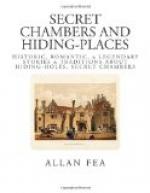The wing of this old mansion which has survived to see the twentieth century witnessed many strange events. It has welcomed good Queen Bess, guarded the Martyr King, and refused admittance to Dutch William. A couple of centuries after it had sheltered hunted Jesuits, a descendant of William Penn became possessed of it, and cleared away many of the massive walls, in some of which—who can tell?—were locked up secrets that the rack failed to reveal—secrets by which Owen “murdered himself” in the Tower!
One of the hiding-places at Hindlip, it will be remembered, could be supplied with broth, wine, or any liquid nourishment through a small aperture in the wall of the adjoining room. A very good example of such an arrangement may still be seen at Irnham Hall, in Lincolnshire.[1] A large hiding-place could thus be accommodated, but detection of the narrow iron tube by which the imprisoned fugitive could be kept alive was practically impossible. A solid oak beam, forming a step between two bedrooms, concealed a panel into which the tube was cunningly fitted and the step was so arranged that it could be removed and replaced with the greatest ease.[2]
[Footnote 1: The fire which destroyed a wing of Irnham Hall a few years ago fortunately did not touch that part of the building containing a hiding-place.]
[Footnote 2: Harvington Hall, mentioned hereafter, has a contrivance of this kind.]
The hiding-place at Irnham (which measures eight feet by five, and about five feet six inches in height) was discovered by a tell-tale chimney that was not in the least blackened by soot or smoke. This originally gave the clue to the secret, and when the shaft of the chimney was examined, it was found to lead direct to the priest’s hole, to which it afforded air and light.
Had not the particular hiding-place in which Garnet and his companions sought shelter been discovered, they could well have held out the twelve days’ search. As a rule, a small stock of provisions was kept in these places, as the visits of the search parties were necessarily very sudden and unexpected. The way down into these hidden quarters was from the floor above, through the hearth of a fireplace, which could be raised an lowered like a trap-door.[1]
[Footnote 1: See Fowlis’s Romish Treasons.]
In a letter from Garnet to Ann Vaux, preserved in the Record Office, he thus describes his precarious situation: “After we had been in the hoale seven days and seven nights and some odd hours, every man may well think we were well wearyed, and indeed so it was, for we generally satte, save that some times we could half stretch ourselves, the place not being high eno’, and we had our legges so straitened that we could not, sitting, find place for them, so that we both were in continuous paine of our legges, and both our legges, especially mine, were much swollen. We were very merry and content within, and heard the searchers every day most curious over us, which made me indeed think the place would be found. When we came forth we appeared like ghosts."[2]




